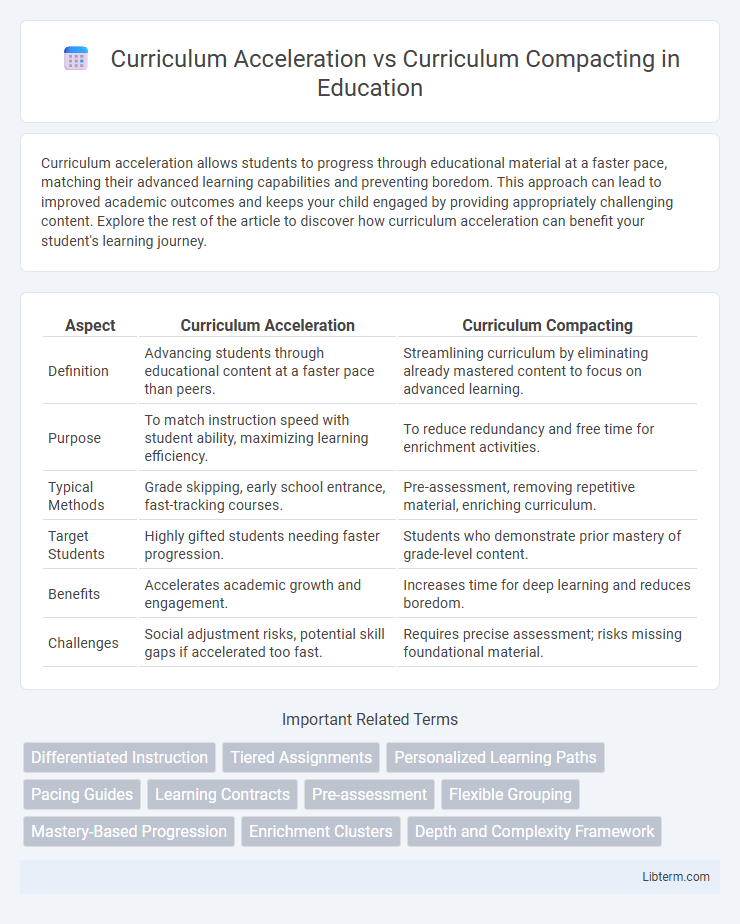Curriculum acceleration allows students to progress through educational material at a faster pace, matching their advanced learning capabilities and preventing boredom. This approach can lead to improved academic outcomes and keeps your child engaged by providing appropriately challenging content. Explore the rest of the article to discover how curriculum acceleration can benefit your student's learning journey.
Table of Comparison
| Aspect | Curriculum Acceleration | Curriculum Compacting |
|---|---|---|
| Definition | Advancing students through educational content at a faster pace than peers. | Streamlining curriculum by eliminating already mastered content to focus on advanced learning. |
| Purpose | To match instruction speed with student ability, maximizing learning efficiency. | To reduce redundancy and free time for enrichment activities. |
| Typical Methods | Grade skipping, early school entrance, fast-tracking courses. | Pre-assessment, removing repetitive material, enriching curriculum. |
| Target Students | Highly gifted students needing faster progression. | Students who demonstrate prior mastery of grade-level content. |
| Benefits | Accelerates academic growth and engagement. | Increases time for deep learning and reduces boredom. |
| Challenges | Social adjustment risks, potential skill gaps if accelerated too fast. | Requires precise assessment; risks missing foundational material. |
Introduction to Curriculum Acceleration and Compacting
Curriculum acceleration involves advancing students through educational programs at a faster pace, often by skipping grades or completing courses in less time, to match their advanced learning abilities. Curriculum compacting streamlines the standard curriculum by eliminating content students have already mastered, allowing them to focus on enriched or advanced material without unnecessary repetition. Both approaches aim to optimize educational efficiency and challenge gifted learners by tailoring instruction to their individual readiness and learning speed.
Defining Curriculum Acceleration
Curriculum acceleration involves advancing students through educational content at a faster pace than typical grade-level expectations, enabling them to engage with more challenging material earlier. This approach includes grade-skipping, early entrance to school, and subject acceleration, aiming to match curriculum rigor with the student's readiness and ability. Research demonstrates that acceleration positively impacts academic achievement without adverse social or emotional effects.
Understanding Curriculum Compacting
Curriculum compacting involves assessing students' prior knowledge to eliminate already mastered content, allowing them to move more quickly through the material while maintaining academic rigor. Unlike curriculum acceleration, which moves students through entire grade levels faster, compacting streamlines specific units within the curriculum for more efficient learning. This targeted approach maximizes instructional time by focusing on new and challenging concepts tailored to each student's readiness.
Key Differences Between Acceleration and Compacting
Curriculum acceleration involves advancing students through educational content at a faster pace or allowing them to skip grades, emphasizing early exposure to more complex material and broader grade-level challenges. Curriculum compacting eliminates repetition by streamlining the curriculum, focusing on mastery of essential concepts and skills while freeing time for enrichment activities tailored to students' interests and abilities. The key difference lies in acceleration accelerating progression through content and grades, whereas compacting optimizes content delivery within the same grade level to maximize efficiency and deepen learning.
Benefits of Curriculum Acceleration
Curriculum acceleration offers significant benefits by allowing gifted students to progress through education at a faster pace, which enhances academic motivation and reduces boredom. It provides early access to advanced content, fostering deeper knowledge acquisition and intellectual growth. Research shows accelerated learners often achieve higher academic outcomes and demonstrate improved self-esteem compared to peers in traditional grade placements.
Advantages of Curriculum Compacting
Curriculum compacting streamlines the learning process by eliminating redundant content, allowing gifted students to engage with advanced material sooner and at a personalized pace. This method enhances student motivation and reduces boredom by focusing on mastery and enrichment activities that align with their readiness and interests. Compacting also supports differentiated instruction, resulting in improved academic outcomes and higher student satisfaction.
Challenges and Considerations
Curriculum acceleration challenges include addressing students' social-emotional readiness and ensuring access to advanced content without gaps in foundational knowledge, while curriculum compacting requires careful identification of mastered skills to prevent redundant instruction. Considerations involve balancing pacing with depth of understanding and providing appropriate support to maintain student motivation and engagement. Both approaches necessitate ongoing assessment and collaboration between educators, students, and parents to optimize learning outcomes.
Identifying Suitable Students
Identifying suitable students for curriculum acceleration involves assessing learners who demonstrate exceptional academic performance, rapid mastery of material, and advanced cognitive abilities beyond grade level expectations. In contrast, curriculum compacting targets students who show proficiency in specific subject areas, enabling educators to streamline instructional time by eliminating content mastery they have already achieved. Both approaches require detailed diagnostic assessments and continuous monitoring to ensure alignment with individual student readiness and learning pace.
Implementing Acceleration and Compacting in Schools
Implementing curriculum acceleration in schools involves providing gifted students with opportunities to move through educational material at a faster pace, often through grade skipping or advanced placement options. Curriculum compacting requires assessing students' mastery of content and streamlining instruction by eliminating material they have already mastered, thereby freeing time for enrichment activities. Effective application of both strategies depends on teacher training, ongoing assessment, and strong communication among stakeholders to tailor learning experiences that challenge students while addressing their individual needs.
Conclusion: Choosing the Right Approach
Curriculum acceleration is ideal for gifted learners who quickly master standard content and benefit from advancing grade levels to maintain engagement and challenge. Curriculum compacting suits students ready to skip redundant lessons by streamlining the curriculum and allowing time for enrichment activities. Selecting the right approach depends on assessing student readiness, learning pace, and the availability of support to maximize educational growth and motivation.
Curriculum Acceleration Infographic

 libterm.com
libterm.com